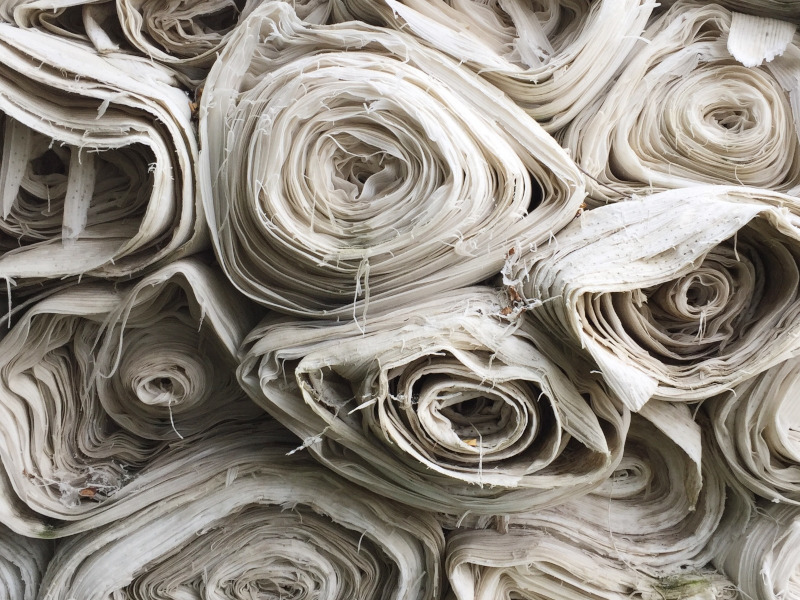An Easy Guide to Textile Recycling

Recycling can be a little intimidating, right? I mean, seriously—with all the little numbers?! I actually feel like I have a pretty good grasp on plastic, glass, and cardboard now, but I’ve got a whole new recycling world to navigate: clothes and textile recycling. What the heck are we supposed to do with ripped jeans, baby food stained onesies, and holey underwear?
Reusing and recycling old clothes and textiles may not seem like a big deal, but it can have a huge impact on the environment and on labor practices. 81 pounds of textile waste is thrown away annually per person in the US, but 95% of these textiles can be reused or recycled.
Textile recycling extends the life of our clothes and fabrics, keeping more waste out of landfills and reducing the demand for unethically produced clothing and textiles. Plus, it might even spur you on to some creative endeavors, and it could even make you some money (read on!).
So, don't let textile or clothes recycling intimidate you! We've put together a 4-step process to make sure we're getting the most use out of our fabric and textiles. And to make it even easier, they all start with “Re.”
Resell (or donate)

We live in a good time to resell clothes. There are a thousand secondhand shopping apps out there (I use Mercari), plus Facebook Marketplace, Craigslist, and resale and consignment shops. By reselling our stuff, we’re not only prolonging the life of our clothes, we’re helping someone else shop ethically too! And making some money. Not bad.
To make it even easier for you, some brands will even buy back their old clothes and give you store credit for them (check out Patagonia’s Worn Wear program).
If you don’t want to put the work into reselling, you can always donate to a thrift store or other local charity (call first to make sure they are accepting donations).
Before you donate old clothes, ensure that they are clean, dry, and free from pests. When you drop off, make sure you leave your donations with an actual person instead of by a door to be picked up later. If clothes are or become ruined or contaminated, the whole donation will likely be thrown away, and that defeats the whole purpose of donating, right?
Reimagine

It’s the age of DIY and Pinterest, right? You can find a tutorial to turn pretty much anything into anything else.
So, before you get rid of that old t-shirt, would you be interested in making it a produce bag? What about turning old baby clothes into a keepsake stuffed animal? Or using old fabric scraps to make a draft stopper? An old sweater into a hat?
I promise you will find a billion ways to DIY something out of whatever you’re getting rid of. Here’s just one post to help you out.
Repair

It may seem simple, but if the average life of clothing was extended by just three months, it would reduce that item’s carbon and water footprints, as well as their generated waste, by up to 10%.
So, before you part with anything, make sure a quick mend, patch, or soak in a stain remover won’t fix it. Don’t forget that you can find a tutorial online to fix just about any problem ever.
Also, check with the clothing brand that made it. Many brands (like DoneGood approved Looptworks and Patagonia) offer warranties on their products and will often fix them for free or for a reasonable price. Patagonia even has tutorials on their website for common repairs to dozens of their products.
Recycle

Okay, your old fabrics are past the point of being resold, repaired, or reimagined. How do you actually recycle old textiles?
Textiles that Can be Recycled
Just about any household textile can be recycled—even stained, torn, threadbare fabrics (am I talking about underwear? Maybe, maybe not). Almost any clean, dry, and odorless fabric can be ground down into fiber and used to make rags, carpet padding, insulation, furniture stuffing, paper, or yarn.
Textiles that Can’t be Recycled
Anything that is mildewed, molded, has an odor after it’s been cleaned, or has been used with a solvent liquid (like gasoline or heavy-duty cleaners) should not be recycled. Wet or dirty fabrics should not be recycled, so make sure you wash and dry your fabrics first to ensure your contribution doesn’t get chunked.
Where to Recycle
This will change depending on where you live. Check first on this handy Recycling Locator. If you can’t find anything there, check with your local thrift store; most of the bigger thrift store chains (e.g. Goodwill) will collect clothes for recycling in addition to taking donations. Finally, some of the bigger retail clothing stores, like H&M, now have in-store recycling bins and will collect clothing and textiles of any brand.

Erin King
DoneGood Contributor
Writer, editor, and all-around language enthusiast who
uses her love of words to help others.
Website



Leave a comment